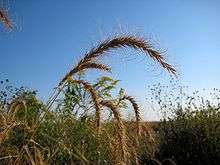Elymus canadensis
| Elymus canadensis | |
|---|---|
 | |
| Scientific classification | |
| Kingdom: | Plantae |
| (unranked): | Angiosperms |
| (unranked): | Monocots |
| (unranked): | Commelinids |
| Order: | Poales |
| Family: | Poaceae |
| Genus: | Elymus |
| Species: | E. canadensis |
| Binomial name | |
| Elymus canadensis L. | |
Elymus canadensis is a species of wild rye known by the common name Canada wild rye. This grass is native to much of North America, being most abundant in the central plains and Great Plains. It grows in a number of ecosystems, including riparian woodlands, many types of forest, lakeside sand dunes, and tallgrass prairie.
Description
Canada wild rye is a perennial bunchgrass reaching heights of 1 to 1.5 metres (3 ft 3 in to 4 ft 11 in). It grows from a small rhizome, forms a shallow, fine root network, and is a facultative mycotroph, receiving about 25% of its nutrients on average from symbiotic mycorrhizae.[1] Its stems are hollow and tough at maturity and bear rough, flat leaves reaching 20 to 30 cm (8 to 10 in) in length.
The inflorescence is a nodding spike up to 25 cm (9.8 in) long containing 5 to 20 spikelets. Each spikelet is 1 to 2 cm (0.4 to 0.8 in) long, not counting the sharp, hard, curling awn which may exceed 3 cm (1.2 in) in length.[1]
Canada wild rye is sometimes used for stabilizing eroded areas and for vegetating metal-rich soils in reclaimed mines.[1]
Elymus canadensis is an allotetraploid, which mainly reproduces by self-pollination, but can cross-pollinate with several other strains of Elymus in order to provide more genetic variation. In addition, because of its ability to cross-pollinate, new species can emerge through nature or breeding programs, thereby contributing more plants that could potentially lead to novel crops.[2] In fact, the cultivar 'Homestead', one of the few plants that has been produced in cultivation by selective breeding of E. canadensis, has been shown to produce larger amounts of forage, and has higher digestibility than other cultivars of Canada wildrye and Virginia wildrye. The current primary use of 'Homestead' is as a conservation plant, along with its use as keeping the soil next to roads from eroding too much. However, its qualities could potentially lead to further research in creating other cultivars of E. canadensis that could possibly be used as crop plants, with higher food yield and digestibility.[3]
Genetic application
The gene pool of Elymus canadensis can provide information on promoting disease resistance in Hordeum vulgare (barley). In two different Elymus canadensis × Hordeum vulgare hybrid groups, the ones with Elymus canadensis cytoplasm were missing a chromosome that was homologous to the barley chromosome 7, and the ones with the Hordeum vulgare cytoplasm were missing a chromosome homologous to barley chromosome 3. The lack of each of the chromosomes in the hybrids was not random, and were caused by differences in DNA myelination. Thus, further research can use these differences in order to figure out what exactly makes Elymus canadensis so hardy, and be able to integrate its hardiness into barley so that the crop can withstand more environmental stress.[4]
Elymus canadensis has also been shown to contain a novel high molecular weight (HMW) glutenin subunit (GS) allele. HMW-GS has been shown in wheat and other crops to determine its overall quality. Thus, further research could elaborate on the E. canadensis allele in order to improve our knowledge of HMW-GS' structural differentiation in different species, and its evolutionary history, in an attempt to increase crop quality through these alleles.[5]
Elymus canadensis has a familiar relationship as a host with a variety of endophytic fungi. Such a symbiotic relationship could be part of the reason why E. canadensis has been so successful as a prairie grass, and may have played a large influence in the grass's evolutionary history. In fact, research suggests that the epichloe do not hinder seed production in the host plant, so the fungi do not obstruct E. canadensis's reproduction, and may in fact aid the process.[6] Further research can expand upon this fungal symbiotic relationship, perhaps to improve the success of agricultural crops. Specifically, research can examine if the different varieties of epichloe will provide E. canadensis with agronomic qualities such as drought tolerance and field production. If this is supported, epichloe may be able to be used to improve the sustainability of crop populations that have a similar genetic makeup to E. canadensis.[7]
References
- 1 2 3 Simonin, Kevin A. (2000). "Elymus canadensis". Fire Effects Information System. U.S. Department of Agriculture, Forest Service, Rocky Mountain Research Station, Fire Sciences Laboratory. Retrieved 19 August 2016.
- ↑ Baum, B; Edwards, T; Poomareva, E; Johnson, D (2012). "Are the Great Plains wildrye (Elymus canadensis) and the Siberian wildrye (Elymus sibiricus) conspecific? A study based on the nuclear 5S rDNA sequences". Botany-Botanique. 90 (6): 407.
- ↑ Vogel, KP; Mitchell, RB; Baltensperger, DD; Johnson, KD; Carlson, IT (2010). "Registration of 'Homestead' Canada Wildrye". Journal of Plant Registrations. 4 (2): 123–126.
- ↑ Dahleen, LS (1996). "Molecular marker analysis of hypoploid regenerants from cultures of barley x Canada wild rye". Genome. 39 (2): 367–372.
- ↑ Jiang, QT; Wei, YM; Lu, ZX; Liu, T; Wang, JR; Pu, ZE; Lan, XJ; Zheng, YL (2010). "Characterization of a novel variant HMW-glutenin gene from Elymus canadensis". Genes & Genomics. 32 (4): 361–367.
- ↑ Saha, MC; Young, CA; Hopkins, AA (2009). "Genetic Variation within and among Wildrye (Elymus canadensis and E. virginicus) Populations from the Southern Great Plains". Crop Science (49): 913–922.
- ↑ Vinton, MA; Kathol, ES; Vogel, KP; Hopkins, AA (2001). "Endophytic fungi in Canada wild rye in natural grasslands". Journal of Range Management. 54 (4): 390–395.